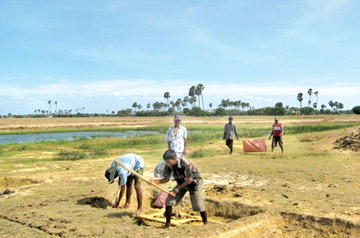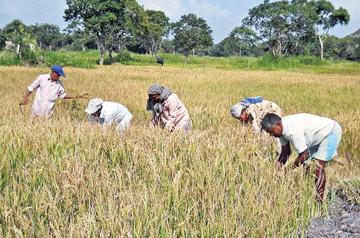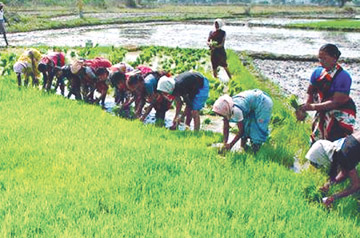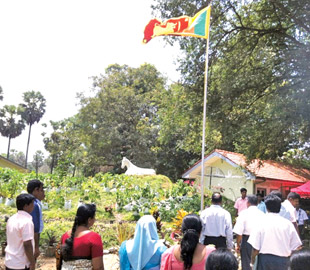|
An economic and agricultural hub:
Vavuniya prospers under mega development programs
By P. Krishnaswamy

A farmer in his paddy field |

The newly constructed school building in a village A farmer in
his paddy field |

Paddy planting in progress |

A bountiful paddy harvest |
 |

Dairy farming in a village |
|

Independence Day celebrations in a rural agrarian centre
|
Vavuniya district , the gateway to the once terrorism-ravaged
Northern province, is fast becoming the hub of economic and agricultural
activities, thanks to the several mega development programs launched by
the Government since the eradication of terrorism five years ago.
Vavuniya district is basically an agricultural district with thousands
of acres of agricultural lands dotted with lakes, ponds or irrigation
tanks and most of the places named after them viz : Rambaikulam,
Marambaikulam, Welikkulam, Puliyankulam Veppankulam, Nelunkulam and
Pavatkulam, the suffix 'kulam' denoting a tank.
The sights that were an eye-sore prior to the military victory, with
ruined bulks of houses and buildings, collapsed ceilings and facades
riddled with bullet holes; roads with potholes and crates, shutters
pulled down on business establishments and all streets virtually
deserted, are no longer to be seen anywhere. There were several check
points where people had to dismount from buses and other transport
vehicles and walk a distance carrying their heavy baggages. The infamous
Omanthai check point and the no-man's zone where people bound to and fro
the North had to change over to other buses. These are nightmares of the
unfortunate past. Buses are now plying to every nook and corner of the
country.
The main focus of the government's development programs is on
promoting agriculture by renovating and rehabilitating irrigation tanks
and bringing all arable lands under cultivation. Since the elimination
of terrorism the investment on such development programs have been in
billions of rupees, Vavuniya GA Bandula Harischandra said. According to
GA Harischandra, the investment sectors, in addition to agriculture and
irrigation, are road networks, water supply, electricity, health,
education and civil administration.
The economy of this District is mainly dependent on Agriculture and
Livestock Farming. These investments facilitate the people to engage in
increased productivity by using improved Irrigation facilities,
electricity, improved road network etc. Consequent to the Government's
development programs, the district has become significant in relation to
its contribution to the GDP in spite of the fact that it is
comparatively smaller in extent viz: 1,967 Sq.Km having a population of
172,000, the GA said. Paddy cultivation is undertaken in an extent of
18,544 Ha and the annual production has reached 83,000 tonnes. A major
portion of all abandoned arable lands have been cleared and utilised for
cultivation. The targeted achievement of paddy cultivation by the year
2016 is 129,200 tonnes . This target is projected to be achieved through
renovation of a more number of irrigation tanks, increased distribution
of quality seed paddy, use of organic fertiliser and more efficient
irrigation technology.
During the past five years the Government has invested Rs.30.914
billion under such programs and the year-wise breakup is Rs.1.517
billion in 2009, Rs.3.263 billion in 2010, Rs.7.148 billion in 2011,
Rs.13.624 in 2012 and Rs.5.362 billion in 2013, according to the GA. The
Government's commitment for last year is Rs.7,613.684 MN and the total
amount spent is Rs.5,362.684 Mn which is 70 percent of the total
commitment, he said.
According to the quarterly physical and financial progress report of
the Director Planning of the Vavuniya District Secretariat a total of
Rs.5.363 Billion has been spent by the different implementing agencies
on development programs , out of the total allocation of Rs.7.613
Billion. The Implementing Agencies /Project and the amount allocated
are:
Rs. 9.9 Mn for Divi Neguma, Rs. 51.50 Mn for the 'Wadakkin
Wasantham', Rs. 24 Mn for the 5,000 Schools Development Program,
Rs.10.74 Mn under the Decentralized Capital Budget, Rs. 129.443 Mn for
the re-awakening program, Rs. 282.73 Mn under the Emergency Northern
Recovery Project (ENReP), Rs. 273.37 Mn for the 'Pura Neguma' (NELSIP)
program, Rs.429.17 Mn under the CARE -Irrigation (Conflict Affected
Region Emergency Project- Irrigation ), Rs. 474 Mn under the CARE Road
(Conflict Affected Region Emergency Project - Roads), Rs. 133.54 Mn
under the NRCP program, Rs.2.39 Billion for the Road Development
(Chinese-funded Project), Rs. 450 Mn for the Dry Zone Urban Water
Sanitation Project, Rs. 15 Mn under the Japan Funded Poverty Reduction
Program 9150, Rs. 53 Mn under the Irrigation Department (Central)
project, Rs. 8.5 Mn under the Irrigation Department (Provincial)
project, Rs. 51 Mn under the ACAD project, Rs. 7.8 Mn under the DDA
project, Rs. 10.5 Mn under the Animal Production and Health project, Rs.
19 Mn under the Department of Fisheries project, Rs. 1.5 Mn under the
Samurdhi program, Rs.2 Mn under the Department of Industries project,
Rs. 179 Mn under the National Housing Development Authority Program,
Rs.01 Mn under the National Youth Services Council program, Rs. 377 Mn
under the Zonal Director of Education - Vavuniya South Program, Rs. 178
Mn under the Zonal Director of Education - Vavuniya North program, Rs.
135 Mn under the Vavuniya Campus program, Rs. 33 Mn under the Road
Development Department , Rs.132 Mn under the Road Development Authority
program, Rs. 28 Mn under the ACLG program, Rs. 332 Mn under the CEB -
'Wadakkin Wasantham' program, and Rs. 1 Billion under the Government
Agent -Vavuniya program. An average percentage of 75 - 100 was utilised
on most of the allocations , while in some cases only between 25 - 50
percent has been utilised up to end of December 2013, according to the
reports of the Director Planning.
The development activities undertaken under the fund allocations
include livelihood programs, industries and trade, rural small scale
enterprises and training on a rural and village level encompassing all
the four Divisional Secretary areas. Under infrastructure development,
formation of gravel to most of the rural and village internal roads,
metaling and tarring of main roads, construction of culverts , provision
of electricity and drinking water were undertaken, aside from
renovation/rehabilitation of urban roads. Resettlement of displaced
people was also part of the development activities, with virtually all
displaced people already having been resettled with provision of the
initial grants for resettlement and government assistance for
construction of houses. Funds were also spent on community resource
development and religious and cultural activities, including
refurbishment/rehabilitation of Hindu temples, Churches and Mosques.
Provision of furniture and other assistance needed for the
maintenance of elders' homes and children's parks and the construction
of new children's parks were also part of the programs in all four
Divisional Secretary divisions. Special focus was laid on promoting
sports among school children through supply of sports material and
renovation of play grounds. While some new school buildings were
constructed, renovation was done to schools requiring immediate
renovation work.
Establishing science labs in some of the schools, contributing books
to school libraries, providing musical instruments and donating public
address systems were also part of the programs.
Strengthening the district administration, construction buildings and
supplying of vehicles were also included in the development programs. In
the health sector too many programs were implemented, including
renovation of buildings and construction of new maternity homes.
Assistance for social welfare and capacity building was extended in many
places.
|

